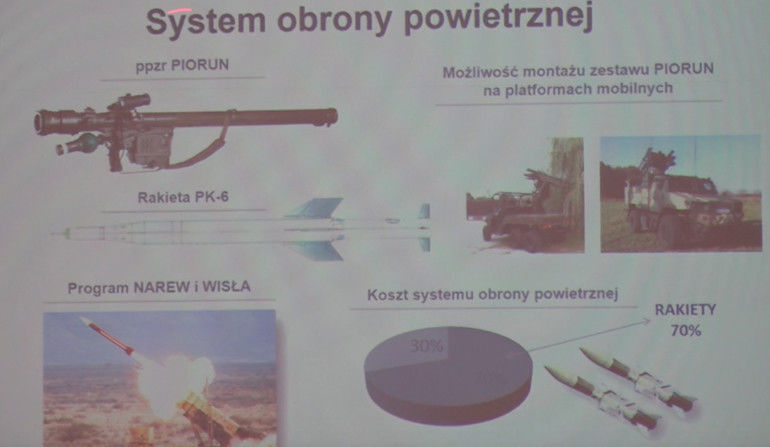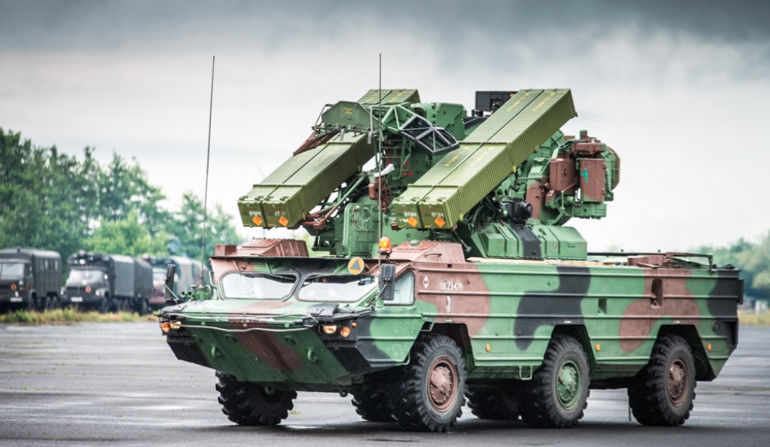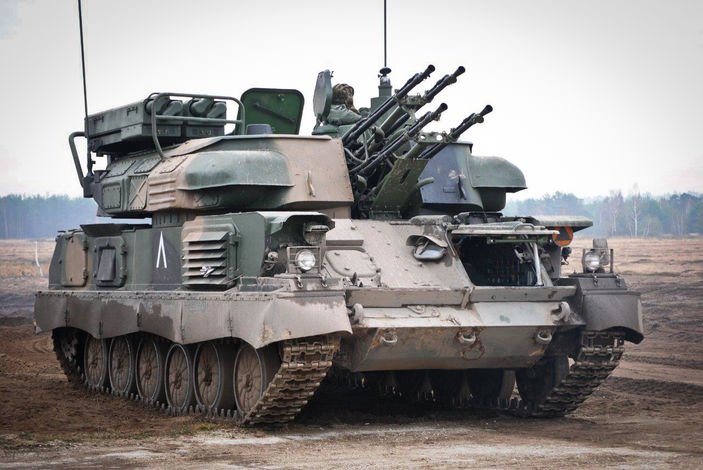Armed Forces
PK-6 Anti-Aircraft Missile. Polish Ordnance for Poprad and Osa Air Defence Systems
Polish companies and R&D facilities have been involved in work concerning the new PK-6 anti-aircraft missile. As a result of the above, a new system with a range of 10 kilometres would be developed, which could become a building block for the Poprad air defence units, modernized Osa systems, as well as for the prospective newly and domestically developed air defence systems that could be used for the purpose of providing anti-aircraft coverage for the land forces.
PK-6 Anti-Aircraft Missile is being developed by the Telesystem-Mesko Implementation and Development Centre, in collaboration with the Mesko S.A. company which is a part of the Polish Armaments Group. The design of that missile is expected to be based solely on the Polish solutions. So far, only the stage of initial development has been reached, also involving the Military University of Technology, however the missile is soon expected to be introduced into production.
– An idea for a new missile, which would form a floor between the floors of SHORAD and VSHORAD system, emerged. – Mariusz Andrzejczak, Deputy Director of the Innovations and Implementation Bureau at the Mesko S.A. Centre for Innovations and Implementation
As Mariusz Andrzejczak, Deputy Director of the Innovations and Implementation Bureau at the Mesko S.A. Centre for Innovations and Implementation has told during a press conference at the opening of the Centre, the new missile would become an intermediate link between the VSHORAD Grom/Piorun systems and the prospective Narew solution, altogether forming the short range air defences layer. It is assumed that the prospective design is to attain a range of 10000 meters, and be capable of destroying airborne targets flying at altitudes of up to 5000 meters. So far, no data concerning the kill-zones or maximum target velocities has been disclosed.
Parameters listed above remain comparable though e.g. to the Korean Pegasus system, US-Swiss ADATS system, British Starstreak II or to the Russian Tunguska SAMs. All of the systems above are used, primarily, to offer direct protection for the armoured or mechanized units on the battlefield. At the moment, modernized Osa and, to a limited extent, Shilka/Biała, systems are tasked with this mission in the Polish Army, and there is a critical need to introduce their successors. Some of the air defence units are going to receive the new Poprad systems in that role.
It is assumed that the new PK-6 Anti-Aircraft Missile could be used as an effector for the Poprad solution, significantly expanding its kill-zone. It also cannot be ruled out that the new missile would be utilized in case of the Osa systems modernized by the domestic industry, e.g. through installation of IFF and thermal vision systems, or through digitalization. Nonetheless, Osa SAM is still, at the moment, armed with Soviet-designed missiles. The modernized Osa system, similarly as Poprad, have optronic systems at their disposal which, potentially, could be utilized to provide guidance to the PK-6 missiles, following a potential modification.

It is expected that 2.3 meters long launch/transport containers are used, while the missile itself is to be 2 meters long with 130 millimetres of diameter. The weight of the whole container is, according to the initial assumptions, of around 65 kilograms. The missile itself weighs 37 kilograms, where 5 kilograms is the weight of the warhead. Thanks to the fact that the above described containers have been used, resistance to the mechanical damage or weather conditions has been greatly enhanced. Moreover, this makes it possible to diminish the degree of the required maintenance and to simplify the process of reloading the missiles and operating them.
The containers themselves, coming in a shape of a cylinder, may be connected into quadruple-missile modules, attached to an automated turret fitted with a relevant optronic system. Such turret, placed on a self-propelled carrier, would form a system capable of autonomous operation, or of operation within a battery. Ultimately, the system should be operated in conjunction with the battery- or higher level of fire control system, within the IADS.

The combined guidance system is going to make use of two methods to get the missile on target – IR guidance and laser guidance. The front section of the missile guidance unit is to be adopted from the Piorun system. The missile is going to be guided towards the source of IR radiation, with the use of optronic IR detection system. On the other hand, the automatic laser guidance unit is to remain active until the target is acquired by the thermal system, should it remain impossible to lock the IR guidance on before the missile is launched.
Most probably, the system is going to be operated in three main modes:
- Automatic mode, with targeting data provided from source to which the system is subordinated;
- Autonomous-Automatic mode – with autonomous destruction of the targets detected within the selected search sector;
- Manual mode – manual searching and interception of the detected target by the missile.
The proposed system has an advantage of being less sensitive to any interference. Such guidance solution also makes it more difficult to detect the launcher itself, during the guidance process. Similarly as in case of other optronically guided missiles. However, the system’s operation may be hampered by bad weather conditions, such as precipitation, fog, cloud cover or dust suspended in the air.
As for now, the manoeuvrability and G-load limits for the missile remain unknown. The guidance is carried out within a single channel.
The project assumes that three engines would be integrated within the system.
- Launch engine, used to propel the rocket out of its container;
- Acceleration engine, providing the missile with a proper velocity (750 meters per second is the assumed value);
- Main engine which, besides the fact that it would maintain the speed, it would also make it possible for the missile to manoeuvre, during the guidance phase.
The acceleration engine, taking most of the missile’s length, is to feature side nozzles, similarly as the main engine, so that the vector of thrust is directed at the angle of 45 degrees in relation to the direction of flight.
According to the initially drafted plans, the research and development stage is expected to last up to 36 months and its cost is going to be as much as PLN 300-400 million. In practical terms this translates into a chance of introducing the PK-6-armed systems in 2021-2022 at the earliest.
Telesystem and Mesko have gathered a lot of experience during the process of developing the Polish Grom and Piorun MANPADSs. Not only is the company in possession of the knowledge required, but it also has a proper research infrastructure and test sites at its disposal, making it possible to test the complete systems in quite realistic conditions. The company claims that components of the previously developed missile systems would also be used in the PK-6 solution, which is entirely based on the domestic design expertise.

The best known products created as a part of the work of the Telesystem-Mesko Sp. z o.o Implementation and Development Centre include the aforesaid Grom and Piorun MANPADSs. The offer of the company is much wider and includes optronic detection and control systems (IR and laser suites with algorithms) for the guided armament, laser target indicators for the semi-active homing systems, autopilots, gyroscope systems or laser systems for guiding the precision guided artillery rounds. The centre has also developed and designed InSb or PbS photo-resistors, specialized control systems for adjusting the missile trajectory or execution systems for the guidance units, and hybrid signal pre-amplifiers. PK-6 Anti-Aircraft Missile would constitute yet another step in development of the centre.
Not only will the successful completion of works be dependent on obtaining the funds required to implement the R&D phase and tests, but also on the interest expressed by the Polish MoD and the continuous support within this long-term and decisive development process. Here it shall be also emphasized that the benefits resulting from the fact that certain technologies may be received from abroad, within the scope of acquiring the medium and short range systems, shall not be compared to those that may be acquired within the framework of the domestic R&D initiatives.
The technology transfers concerning the individual capacities do not translate into acquisition of ability to create new solutions, or into full understanding of the given area of expertise. Moreover, the foreign contractors may not be eager to transfer the armament technology as a whole, which would make it impossible to get acquainted with the technologies and principle of operation of the whole armament system. Thus, expansion of domestic and unique capabilities is quite important, and such steps should be supported, especially in the areas where some significant industrial potential remains available.
Marek Dąbrowski



